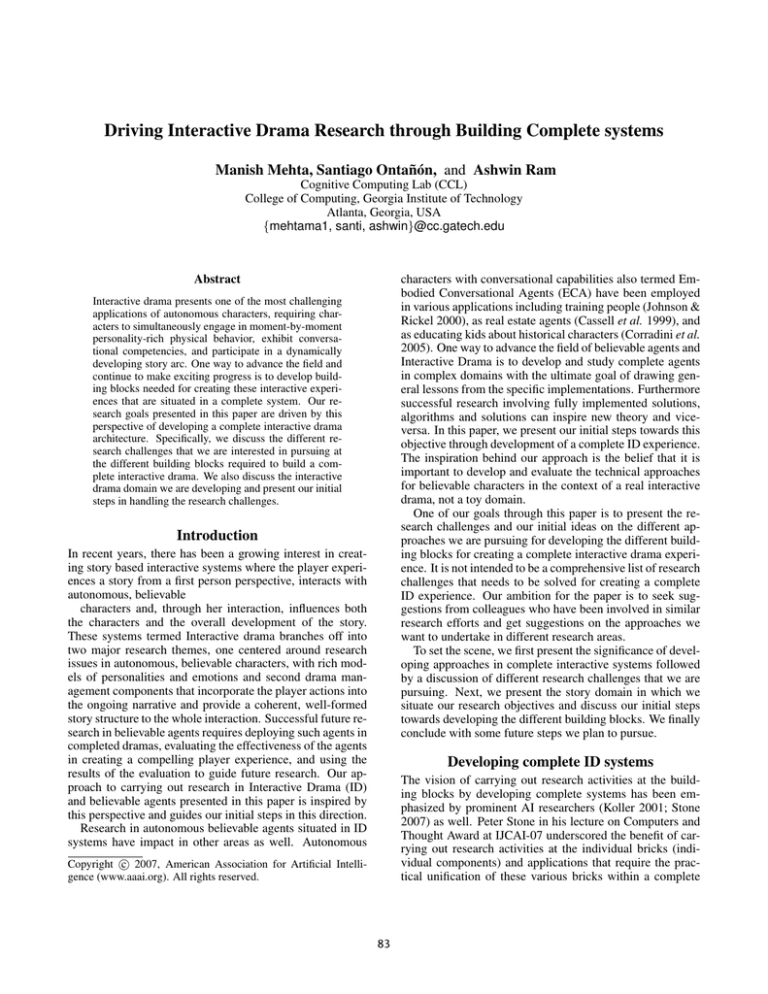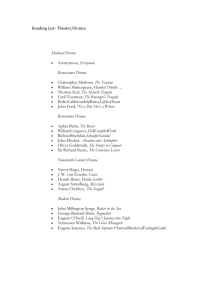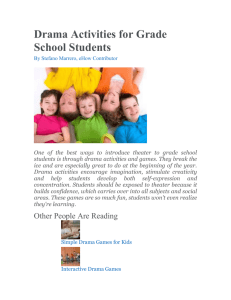
Driving Interactive Drama Research through Building Complete systems
Manish Mehta, Santiago Ontañón, and Ashwin Ram
Cognitive Computing Lab (CCL)
College of Computing, Georgia Institute of Technology
Atlanta, Georgia, USA
{mehtama1, santi, ashwin}@cc.gatech.edu
characters with conversational capabilities also termed Embodied Conversational Agents (ECA) have been employed
in various applications including training people (Johnson &
Rickel 2000), as real estate agents (Cassell et al. 1999), and
as educating kids about historical characters (Corradini et al.
2005). One way to advance the field of believable agents and
Interactive Drama is to develop and study complete agents
in complex domains with the ultimate goal of drawing general lessons from the specific implementations. Furthermore
successful research involving fully implemented solutions,
algorithms and solutions can inspire new theory and viceversa. In this paper, we present our initial steps towards this
objective through development of a complete ID experience.
The inspiration behind our approach is the belief that it is
important to develop and evaluate the technical approaches
for believable characters in the context of a real interactive
drama, not a toy domain.
One of our goals through this paper is to present the research challenges and our initial ideas on the different approaches we are pursuing for developing the different building blocks for creating a complete interactive drama experience. It is not intended to be a comprehensive list of research
challenges that needs to be solved for creating a complete
ID experience. Our ambition for the paper is to seek suggestions from colleagues who have been involved in similar
research efforts and get suggestions on the approaches we
want to undertake in different research areas.
To set the scene, we first present the significance of developing approaches in complete interactive systems followed
by a discussion of different research challenges that we are
pursuing. Next, we present the story domain in which we
situate our research objectives and discuss our initial steps
towards developing the different building blocks. We finally
conclude with some future steps we plan to pursue.
Abstract
Interactive drama presents one of the most challenging
applications of autonomous characters, requiring characters to simultaneously engage in moment-by-moment
personality-rich physical behavior, exhibit conversational competencies, and participate in a dynamically
developing story arc. One way to advance the field and
continue to make exciting progress is to develop building blocks needed for creating these interactive experiences that are situated in a complete system. Our research goals presented in this paper are driven by this
perspective of developing a complete interactive drama
architecture. Specifically, we discuss the different research challenges that we are interested in pursuing at
the different building blocks required to build a complete interactive drama. We also discuss the interactive
drama domain we are developing and present our initial
steps in handling the research challenges.
Introduction
In recent years, there has been a growing interest in creating story based interactive systems where the player experiences a story from a first person perspective, interacts with
autonomous, believable
characters and, through her interaction, influences both
the characters and the overall development of the story.
These systems termed Interactive drama branches off into
two major research themes, one centered around research
issues in autonomous, believable characters, with rich models of personalities and emotions and second drama management components that incorporate the player actions into
the ongoing narrative and provide a coherent, well-formed
story structure to the whole interaction. Successful future research in believable agents requires deploying such agents in
completed dramas, evaluating the effectiveness of the agents
in creating a compelling player experience, and using the
results of the evaluation to guide future research. Our approach to carrying out research in Interactive Drama (ID)
and believable agents presented in this paper is inspired by
this perspective and guides our initial steps in this direction.
Research in autonomous believable agents situated in ID
systems have impact in other areas as well. Autonomous
Developing complete ID systems
The vision of carrying out research activities at the building blocks by developing complete systems has been emphasized by prominent AI researchers (Koller 2001; Stone
2007) as well. Peter Stone in his lecture on Computers and
Thought Award at IJCAI-07 underscored the benefit of carrying out research activities at the individual bricks (individual components) and applications that require the practical unification of these various bricks within a complete
c 2007, American Association for Artificial IntelliCopyright gence (www.aaai.org). All rights reserved.
83
of output text produced by the agents should be modified
based on the personality and the emotional state of the
character without adding a lot of authorial burden on the
author. The system should also be able to provide enough
generative abilities so as to undercut the cost of developing it.
cathedral (complete agents). Koller in her 2001 computers
and Thought lecture presented a similar vision where she
emphasized the notion that in AI, as in many communities,
we have the tendency to divide a problem into well-defined
pieces, and make progress on each one. But as progress
is made, the problems tend to move away from each other
(Koller 2001). One way of approaching and combating this
issue of fragmented solutions is to create fully functional
agents in complex domains and build applications that require practical unification of the various individual topics
into a complete agent.
In Interactive drama and believable agents research, this
vision has been realized in Facade (Mateas & Stern 2003).
Our objective towards this vision is to understand and facilitate development of adaptive autonomous characters in the
context of advanced interactive systems. While there has
been a considerable amount of research in research issues in
individual pieces required to develop a complete interactive
drama experience, with the exception of Facade, there has
been little effort in incorporating all of them together into a
full fledged system. One of the hazards in not doing so is
that research in the individual problems might be deviating
too much from the real need in a real system. While developing a commercial-quality interactive drama is not one of
our research objectives, our goal is to have a realistic domain that provides a setup for us to develop viable representations and techniques and a platform for realistic evaluation
to guide future research.
• Drama Management and Player Modeling: There is
a growing interest in developing Drama Manager (DM)
components for story based games that gently guide the
player towards a story ending that exhibits a narrative
arc. The application of DM approaches in real large scale
games raises several research issues such as scalability,
long term story planning and player modeling issues. Further Drama Management approaches require a “model”
that predicts the interestingness of story arcs, so that the
drama manager can plan which story arcs to pursue and
provide a better player experience.
To ground our discussion, next, we present the story domain in which we are pursuing our different research goals.
Story Domain : Mystery Mansion
The interactive drama we are developing is named Mystery
Mansion (MM). The story set up consists of six characters
and is set up in a British mansion at the beginning of the
20th century. The player controls one of the character and is
free to interact with the rest of the characters using natural
language and also move freely around the house and manipulate some objects. In particular, the drama starts when two
of the characters decide to celebrate an engagement party,
and invite two friends to a dinner in their newly acquired
mansion. The remaining two characters are the butler of
the house and the father of the bride. Most of the characters have strong feelings (love or hate) for some of the other
characters, and as the story unfolds the player will discover
hidden relations between them. The player will take the role
of one out of three possible characters and will be able to act
freely in the mansion, with his actions strongly influencing
the development of the game.
The story consists of four big scenes: the cocktail party,
where all the characters arrive to the mansion and meet;
the dinner, where some initial discussions appear; the night,
where the characters go to sleep in the mansion and one (or
several) murders will happen; and finally the investigation,
where the survivors will try to investigate the murder. Depending on the player actions, each scene might happen in
several different ways; specially the third scene, where there
are about 10 possible different murders that can happen depending on what the player does. The player himself might
get killed, or a combination of murders can happen. The investigation is an open ended scene where the murderer may
or may not be discovered (the player himself might be implicated in the murderer and he will have to cover himself).
Such a game will provide a perfect opportunity to combine
all the previously mentioned research goals into a real application. In the remaining sections we provide a brief description of our initial steps towards the individual research
challenges we plan to pursue through the development of
Mystery Mansion .
Research Challenges
Some of the research challenges that we plan to undertake
through the development of a fully fledged 3D real-time interactive story development are listed below:
• Behavior Authoring support through behavior learning and runtime behavior modification Hand crafted
behaviors are, ultimately, software code in a complex programming language, prone to human errors. The behavior
errors could be in the form of program bugs or not achieving the desired result. Another issue is that hand authoring
of behavior for believable character though allows designers to craft expressive behavior for characters, but nevertheless leads to excessive authorial burden (Magerko &
Laird 2003). Tools are needed to support story authors,
who are typically not artificial intelligence experts, to allow them to author behaviors in an easy way.
The initial behavior set for the game characters defined at
design time results in characters that are brittle to changing world dynamics as it is difficult to imagine all the
possible situation that the character would encounter in
the game. Moreover, the repetitive and predictable nature
of character behaviors can hamper the player experience.
The key problem then, is to develop a self adapting system for these characters that is autonomously responsive
to new and unforeseen circumstances keeping the authorspecified personalities in mind.
• Natural Language Generation: Interactive domains inhabited with believable characters provide rich opportunities for Natural Language Generation (NLG). The style
84
Behavior Authoring support
of the interactions of the characters with the player and with
each other, relative to the primary rhetorical objectives of
the game and the individual goals of the embedded characters, thereby relieving the author of writing behaviors for all
possible circumstances.
In our previous approach, we have dealt with some of the
research issues listed above (Zhang et al. 2007). To address
these issues, we have developed an approach in which agents
keep track of the status of their executing behaviors, infer
from their execution trace what might be wrong, and perform appropriate revisions to their behaviors. We want to
push our behavior adaptation approach further through the
development of Mystery Mansion domain. We are developing an architecture called Automatic Behavior Adaptation
architecture (ABA) to deal with the issue of dynamic behavior modification. The architecture has three main components, the character execution component A behavior Language (ABL) (Mateas & Stern 2002), the introspection component, and the behavior modification component.
The behavior execution component, based on the ABL
behavior language, manages the behavior of the non player
characters in the game. To do so, the game state is read
through a series of sensors that update the working memory. The ABL runtime component selects which behaviors
(from the behavior library) will be executed to pursue the
current character goals as a function of the content of working memory, and tracks current goals and behaviors to determine if any should spontaneously succeed or fail because
of changes in the world. ABL keeps track of the current
active subgoals and behaviors in the Active Behavior Tree.
The introspection component is one of the key modules in
the architecture. Its goal is to monitor that the character
behavior is satisfying the declarative behavioral constraints
for each character, and to perform blame assignment if they
are not. The behavior modification component job is to receive modification requests, and modify ABL behaviors to
fix constraint violations detected by the introspection module. Once a behavior has been modified, it will be pushed
back into the behavior execution component (the behavior
library of an executing ABL agent).
Behavior authoring is the major bottleneck in interactive
drama development. The standard approach for authoring
autonomous characters is to hand-author behaviors or scripts
that describe the character’s reaction in all possible circumstances within the game world. This approach of authoring characters presents several difficulties such as difficulty
in planning for all possible scenarios a character might encounter and repetitive behavior harming the believability of
the characters. One of the key issue, then, is the ability to
construct or adapt behavior sets.
In this section we propose two complementary approaches to deal with such problem, namely: behavior learning from demonstrations and behavior modification.
Behavior Learning from Demonstrations
Story authors are typically non AI expert, and thus defining behaviors using a programming language is not an easy
task for them. They have a clear idea in mind of the behavior they want particular characters in the game to exhibit,
but the barrier is encoding those ideas into actual code. An
approach to address that issue is programming by demonstration, where authors actually demonstrate the behavior a
character must exhibit (by controlling that character manually) and the system learns from that demonstration.
In a previous approach, we have successfully developed
a system capable of learning behaviors from demonstration
in a real-time strategy (RTS) domain (Ontañón et al. 2007),
specifically in the game of Wargus (an open source implementation of the classic Warcraft 2). We use a case-based
approach, where each individual behavior that is learnt is
stored as a case. In our approach, an expert plays a game of
Wargus showing a particular strategy that he wants to teach
to the system. The result of that game is an execution trace
that the expert can annotate by pointing out which were the
goals he was pursuing with the actions he was doing. The
system can then analyze such annotated trace and infer behaviors to achieve the goals the expert has annotated. For
each behavior that the expert has demonstrated, the system
stores the particular game state in which it was executed.
The combination of a goal, a behavior and a game state defines a case. Thus, the system can learn several different
behaviors to achieve the same goal, and store in which situation each different behavior is better.
On execution time, when the system needs to achieve a
particular goal (e.g. “destroy an enemy tower” in the Wargus
domain), it will look for behaviors in its learned behavior
library to destroy towers, and will select the one that is most
appropriate by comparing the current game state with the
game states stored with each behavior, i.e. the case retrieves
the most appropriate case.
The described approach has been successfully validated
in the context of real-time strategy games. Thus, the next
research challenge is to apply it to interactive drama, where
the behaviors involve verbal and gesture actions, in addition
to the motion and physical actions already considered in the
framework of RTS games.
Behavior Modification
Another approach to deal with the authoring consisting of
modify behaviors on an ongoing basis through an analysis
Drama Management
Drama Management approaches have been shown to improve player satisfaction in the context of interactive games
(Sharma et al. 2007b; 2007a). However, there are several
challenges that have to be solved in order to incorporate
drama management into complex games such as MM . Typically, drama managers use search based techniques to decide
which are the best actions to select at any moment. However, in a big complex game, the amount of possible actions
available is so large, that search based techniques cannot be
directly applied. Moreover, previous drama management approaches do not take into account the timing problem, i.e. in
addition to decide which actions the drama manager should
take, also decide when to take them. An exception to that,
is the work done in Façade (Mateas & Stern 2003), where
they use beats to model timing. In a real-time game such
as Façade or MM the timing problem is crucial, and should
be taken into account. The research topics related to drama
85
management that MM will allow us to develop are related to
a) Player preference and action modeling i.e modeling which
story arcs, drama manager interventions or other game elements a particular player might enjoy and further modeling
which actions each particular players are likely to execute
in any given situation, b) DM action selection and timing,
i.e. optimizing the search process and learn the best action
instead of searching for it and deciding the proper timing
for DM actions is as important as which actions to select to
achieve a good game dynamics and c) Proper story representation for a complex domain like MM.
In our previous approach (Sharma et al. 2007b) towards
drama management we have tackled the issues of player
preference modeling, story representation and DM action
selection. We want to move forward and start tackling the
research challenges mentioned above for MM.
drama experience. As a future step, we are pursuing work in
each of the individual components forward.
Acknowledgement
The authors would like to thank Michael Mateas, author of
the ABL language and collaborator on the behavior modification project, Peng Zang for behavior modification, Manu
Sharma for drama management work, and Christina Strong
for the NLG system.
References
Cassell, J.; Bickmore, T.; Billinghurst, M.; Campbell, L.;
Chang, K.; Vilhjalmsson, H.; and Yan, H. 1999. Embodiment in conversational interfaces: Rea. In Proceedings
of the SIGCHI conference on Human factors in computing
systems, 520–527.
Corradini, A.; Mehta, M.; Bernsen, N. O.; and Charfuelan,
M. 2005. Animating an interactive conversational character for an educational game system. In Proceedings of
Conference on Intelligent User Interfaces.
Johnson, W. L., and Rickel, J. W. 2000. Animated
pedagogical agents: Face-to-face interaction in interactive
learning environments. International Journal of Artificial
Intelligence in Education.
Koller, D. 2001. Representation reasoning learning. In
IJCAI Computers and Thought Award talk.
Magerko, B., and Laird, J. 2003. Building an interactive
drama architecture. In In Proceedings of TIDSE, 226–237.
Mateas, M., and Stern, A. 2002. A behavior language
for story-based believable agents. IEEE intelligent systems
and their applications 17(4):39–47.
Mateas, M., and Stern, A. 2003. Facade: An experiment
in building a fully-realized interactive drama. In In Game
Developer’s Conference: Game Design Track.
Ontañón, S.; Mishra, K.; Sugandh, N.; and Ram, A. 2007.
Case-based planning and execution for real-time strategy
games. In Proc. of International Conference Case Based
Reasoning.
Sharma, M.; Mehta, M.; Ontañón, S.; and Ram, A. 2007a.
Player modeling evaluation for interactive fiction. In AIIDE
2007 Workshop on Optimizing Player Satisfaction.
Sharma, M.; Ontañón, S.; Strong, C.; Mehta, M.; and Ram,
A. 2007b. Towards player preference modeling for drama
management in interactive stories. In FLAIRS 2007. AAAI.
Stone, P. 2007. Learning and multiagent reasoning for autonomous agents. In IJCAI Computers and Thought Award.
Strong, C.; Mehta, M.; Mishra, K.; Jones, A.; and Ram,
A. 2007. Emotionally driven natural language generation
for personality rich characters in interactive games. In To
appear in AIIDE 2007.
van Deemter, K.; Krahmery, E.; and Theunez, M. 2003.
Real vs. template-based natural language generation: a
false opposition? Ass. for Computational Linguistics.
Zhang, P.; Mehta, M.; Mateas, M.; and Ram, A. 2007.
Towards runtime behavior adaptation for embodied characters. In Proceedings of IJCAI.
Natural Language Generation
In general, there is a lack of reusability in NLG tools. In
our previous work (Strong et al. 2007), we decided to start
from scratch and build a system that is reusable across game
domains. Our initial system uses a set of author defined
templates that can be reused across different characters and
emotional states. We defined these templates as a set of sentence structures that require words and phrases from a lexicon to complete the sentence. The words and phrases that
are used are dependent upon the parameters given by the output from the emotion and game event tracking. We chose to
use templates for several different reasons. There is a convincing argument by van Deemter et al. (van Deemter, Krahmery, & Theunez 2003) that there is no need to distinguish
between “template-based” natural language generation and
“real” natural language generation. At this point, both technologies have their advantages, and vary as widely within
their own class as between classes.
Our previous approach to deal with NLG issues (Strong et
al. 2007) provides us a starting point in situating our work
in an interactive domain. However, as the domain is not
fully conversation centered, the opportunities to deal with issues of a real time conversation-centered domain are limited.
Moving forward our work, we are extending the approach in
Mystery Mansion . As described above, the story of Mystery Mansion is primarily divided into four scenes. We have
currently developed hierarchical templates for verbal output
generation for the first two scenes. The two scenes consist of
approximately 6000 (approx 400 lines) words of dialog. The
goal for creating hierarchical templates is to reuse different
templates across the different scenes and characters.
Conclusion
We share the perspective of various AI researchers (Koller
2001; Stone 2007) and prominent interactive drama researchers (Mateas & Stern 2003) emphasizing the benefit
of developing applications that require the practical unification of these various sub-components within a complete
system. In this paper, we have presented our initial ideas on
the research activities that we plan to undertake at the various building blocks situated within a complete interactive
86






